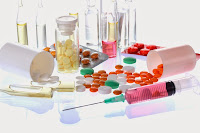The male (androgenic) hormone is called testosterone. It stimulates the growth of cancerous prostatic cells and, therefore, is the primary fuel for the growth of prostate cancer.
The idea of all of the hormonal treatments (medical and surgical), in short, is to decrease the stimulation by testosterone of the cancerous prostatic cells. Testosterone normally is produced by the testes in response to stimulation from a hormonal signal called LH-RH. The LH-RH stands for luteinizing hormone-releasing hormone and is also called gonadotropin-releasing hormone. This hormone comes from a control station in the brain and travels in the bloodstream to the testes. Once there, the LH-RH stimulates the testes to produce and release testosterone.
Hormonal treatment, also referred to as androgen deprivation (depriving the prostate of testosterone), can be accomplished surgically or medically.
 |
| Hormonal Treatment For Prostate Cancer |
- The surgical hormonal treatment is removal of the testes in an operation called an orchiectomy or a castration. This surgery thus removes the body's source of testosterone.
- The medical hormonal treatment involves taking one or two types of medication. One type is referred to as the LH-RH agonists. They work by competing with the body's own LH-RH. These drugs thereby inhibit (block) the release of LH-RH from the brain. The other type of drug is referred to as anti-androgenic, meaning that these drugs work against the male hormone. That is, they work by blocking the effect of testosterone itself on the prostate.
Today, most men electing hormonal treatment choose medication over surgery, probably because they view surgical castration as more devastating cosmetically or psychologically. Actually, however, the effectiveness and side effects of medical hormonal treatment as compared to surgical hormonal treatment are very much the same.
Both types of hormonal treatment usually effectively eliminate stimulation of the cancer cells by testosterone. Some tumors of the prostate, however, do not respond to this form of treatment. They are referred to as androgen-independent prostate cancers. The principal side effects of all of these hormonal treatments (that is, the side effects of androgenic deprivation) are enlarged breasts (gynecomastia) that often are tender, flushing (like hot flashes), and impotence.
The LH-RH agonists, leuprolide (Lupron) or goserelin (Zoladex), are given as monthly injections in the doctor's office.
The anti-androgenic drugs, flutamide (Eulexin) or bicalutamide (Casodex), are oral capsules that are used usually in combination with the LH-RH agonists.
The LH-RH agonists are often effective alone. The anti-androgenic drugs are added, however, if the cancer progresses despite the use of the LH-RH agonists. The hormonal treatments may have value, as well, when combined with radiation therapy. Current evidence suggests that hormonal therapy enhances the therapeutic effect of radiation.
Generally, hormonal treatment is reserved for individuals who have advanced prostate cancer with local spread or metastases. Occasionally, an individual with organ-confined (localized) prostate cancer will receive hormonal treatment because he has severe associated medical problems or simply because he refuses to undergo surgery or radiation.
Hormonal treatment is used in less than 10% of men with organ-confined (localized) prostate cancer. Remember that the intent of hormonal therapy usually is palliative. This means that the goal is to control the cancer rather than cure it because a cure is not possible.